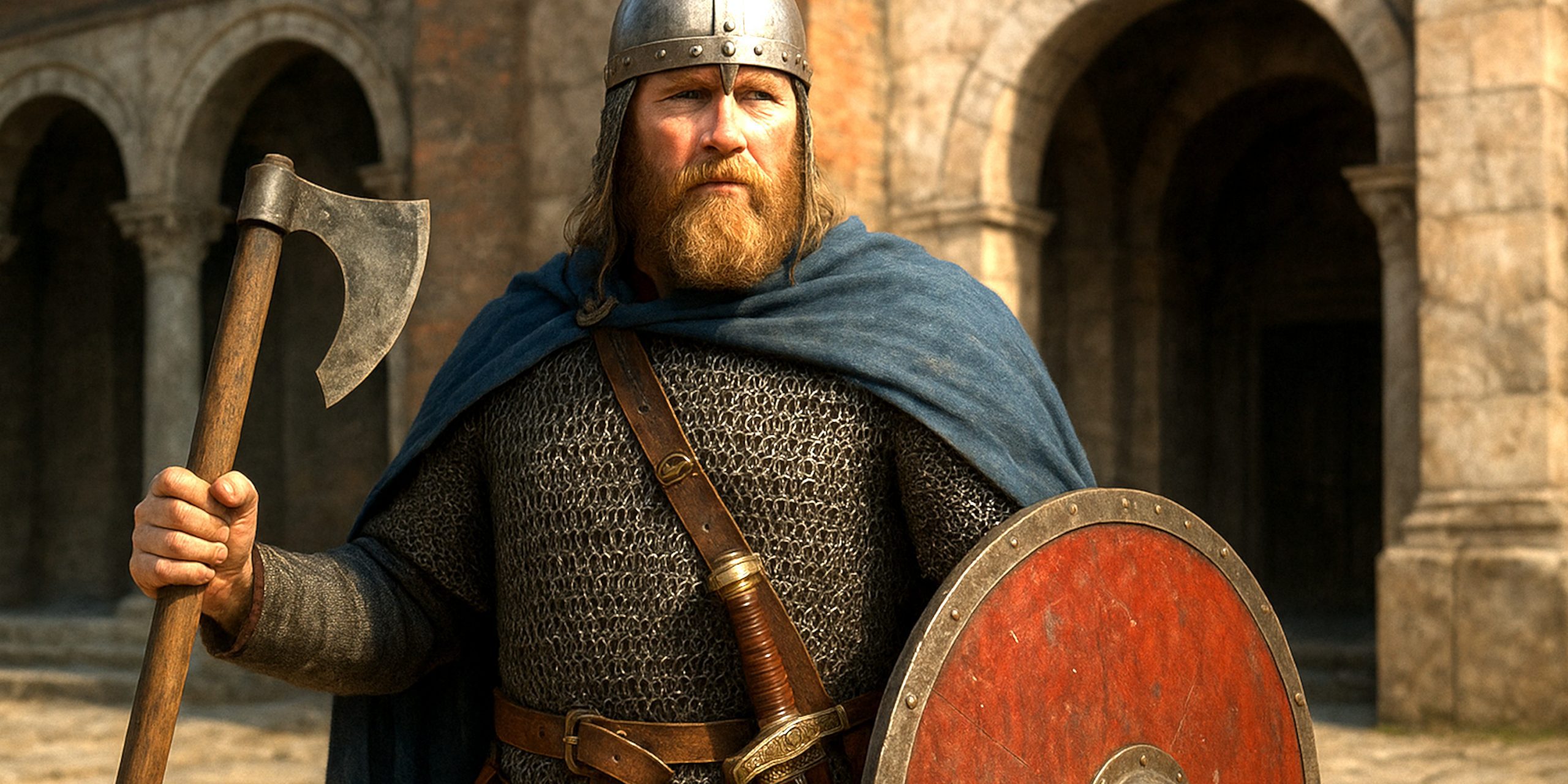
There are elite units that live on mainly through legend, and then there are the Varangian Guards who charged through history with such enthusiasm that even the Byzantines, not known for their understatement, wrote about them with a mix of admiration and alarm. These were warriors from the north, men who arrived in Constantinople with pockets full of silver, an appetite for adventure and a fondness for weapons that really should have required permits.
They served as the personal guard of the Byzantine emperors for centuries. Their loyalty was prized, their reputation fierce and their drinking capacity frankly terrifying. If you ever wanted a job that combined civil ceremony, battlefield chaos and binge spending in Constantinople’s tavern district, the Varangian Guard was the place to be.
Origins And Rise To Fame
The Varangian Guard first appears properly in Byzantine sources in the late tenth century. Emperor Basil the Second needed dependable soldiers to strengthen his position in a turbulent empire. He secured support from the Kievan Rus, receiving a large force of Norse and Rus warriors who would soon evolve into his elite household troops.
The Byzantines valued them for one crucial trait. They were not local. They were not tangled in court politics. They had no loyalties except to the emperor and their own pay. In a court where backstabbing was a thriving sport, having a bodyguard who had never met your cousin plotting against you was very reassuring.
By the eleventh century, English fighters fleeing Norman rule joined their ranks too. This mix of Norse, Rus and Anglo Saxon heritage gave the Guard a distinct identity, a blend of battlefield traditions that produced a unit known across the Mediterranean for its power and discipline.
Service And Reputation
The Varangians saw service in every corner of the empire. They fought in Italy, Syria, the Balkans and Anatolia. Their job varied from fighting on the front lines to standing behind the emperor during ceremonies. If you were an emperor and needed someone very large and very serious to hold a glittering axe beside you, the Varangians were ideal.
Chroniclers noted their loyalty with genuine admiration. Michael Psellos, never shy of an opinion, said they were loyal to the throne almost to a fault. When the emperor moved, they moved. When the emperor needed someone removed, they were already sharpening their axes.
Their only weakness was a fondness for the city’s nightlife. More than one visitor to Constantinople shared tales of Varangians returning from campaigns and spending their entire pay in a heroic burst of tavern related enthusiasm. Honestly, if you marched across half the known world with a three foot axe, you deserved a drink.
Arms And Armour
The Varangian Guard is remembered above all for one weapon, the great two handed axe. This was not a polite, restrained axe. This was an axe that made opposing soldiers reconsider their career choices.
Main Weapons
- Two handed Viking axe, often a bearded or long hafted type
- Single handed Viking axe for close combat
- Straight double edged swords of the late Viking and Anglo Saxon pattern
- Petersen Types S, T and Z
- Anglo Saxon pommel styles with lobed or Trewhiddle ornament
- Later Byzantine influenced spathae as reforms changed equipment layouts
- Seaxes or long fighting knives among early Norse contingents
- Spears for shield wall fighting, particularly in earlier centuries
- Round or kite shields, depending on era
- Mail hauberks, sometimes reaching the knee
- Lamellar cuirasses once they integrated deeper into Byzantine military culture
Armour Characteristics
Early Varangians wore typical northern warrior gear, long mail shirts, conical helmets and combat shields. As centuries passed they adopted more Byzantine kit, including lamellar corselets and crested helmets. Archaeological finds show hybrid armour sets, a sign that the Varangian Guard was never a frozen moment in time but a living unit that adapted as the empire evolved.
Archaeology
Material evidence for Varangian service is scattered across former Byzantine territories. Finds include:
- Axe heads of Scandinavian shape discovered in Greece and western Anatolia
- Anglo Saxon style sword fittings turned up in areas associated with the Guard’s movements
- Runic graffiti in the Hagia Sophia, scratched casually by a Varangian who likely had no idea people would still be studying his doodles a thousand years later
- Byzantine lamellar plates found alongside northern style weapon fragments, indicating mixed equipment sets
- Burial goods in the Crimea and the Balkans, showing Varangian veterans who settled within the empire
Archaeology paints a picture of soldiers who blended cultural traditions. You see Norse forging techniques next to Byzantine ceremonial fittings, a perfect material reflection of their role in the empire.
Contemporary Quotes
The medieval sources did not hold back when describing the Varangians.
John Skylitzes on their impact in battle:
“They struck down all before them and the enemy line broke as if cut with iron.”
Anna Komnene on their loyalty during her father’s reign:
“They were bound to the emperor by oaths stronger than iron and silver.”
Michael Psellos on their general vibe:
“They were feared for their strength, trusted for their faithfulness and known for an enthusiasm for wine matched only by their zeal in war.”
The Guard In Ceremony
The Varangians were not just battlefield brawlers. They played a major role in Byzantine court ritual. They guarded the palace gates, flanked the emperor during processions and provided a sense of raw power at imperial ceremonies. Imagine long rows of tall northerners in polished armour, holding axes that gleamed in the candlelight of Constantinople’s great halls. It was intimidation with a varnish of royal dignity.
Decline
By the late middle ages, the Guard had changed dramatically. The Scandinavian and Rus supply dwindled. English recruits became the majority for a time, though even their numbers faded. By the thirteenth century the Guard still existed but in a reduced form, no longer the unstoppable force of earlier centuries.
The fall of Constantinople in 1453 ended the unit entirely. Yet their legacy survived, both in Byzantine memory and in the sagas and traditions of northern Europe.
Legacy
The Varangians remain one of the most captivating military units in medieval history. They embody a mixture of northern aggression, Byzantine sophistication, battlefield prowess and ceremonial splendour. Modern historians admire them not only for their combat record but for the cultural exchange they represent, a living bridge between the frozen north and the glittering imperial court.
Every culture loves a bodyguard story. The Varangian Guard just happens to be one of the best. Fierce, loyal, occasionally tipsy and always impressive.
Watch the documentary:



